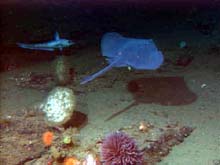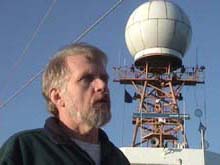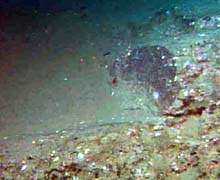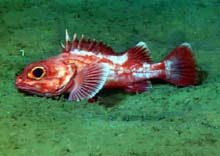
This assemblage of underwater fauna -- a black skate (middle), grenadier (upper left), and sponges and anemones (foreground) -- represents the diverse creatures viewed on ROPOS Dive R602 in the deeper portion of Astoria Canyon. Click image for larger view.
Sedimentary bedding planes dipping approximately 40 degrees support a suite of life forms including an anemone (purple), a white gorgonian(coral), and an anomuran crab. Click image for larger view.
The dark-colored rock represents a freshly broken rock face devoid of organisms. This is in stark contrast to the sedimented and colonized adjacent rock, which is host to a diverse array of benthic invertebrates. Click image for larger view.
An Amazing Assemblage
July 3, 2001
Jeff Goodrich, Teacher-at-sea
Teacher of Earth Science
Lake Oswego High School
Lake Oswego, Oregon
and
Susan Merle, Geological Research Assistant
CIMRS Program, Oregon State University
Vents Program, Pacific Marine Environmental Laboratory, NOAA
Dive R602 of the ROPOS remotely operated vehicle (ROV) was the deepest dive of the Astoria Canyon adventure. It occurred in the westernmost portion of the canyon that we have reached so far, in water depths ranging from 1,350 m at the canyon floor to 900 m in a location where the canyon makes a dramatic turn, first to the south and then to the north. During this dive, the ROV traveled up the side of an anticline, a geological structure in which rock is folded, under pressure, in the shape of an upside-down "V". Our first glance at this part of the canyon revealed an entirely different suite of organisms and habitat than we had seen previously, and was a treat for us all.
As we descended to a water depth of 1,100 m, we were amazed by the abundance of jellyfish drifting by. Our first sight of the sea floor was not the floor of the canyon, but a steep rock wall with various organisms imbedded in its pockmarked surface. We continued to descend to the base of the canyon wall (beds dipping 45 degrees), and witnessed a plethora of life that we had not encountered on any of the previous dives. This habitat provides a unique and favorable environment for the numerous bivalves, gorgonians (e.g., sea fans and sea rod corals), antipatharians (black corals), zoanthids (anemone-like organisma with 12 tentacles), anemones (including Venus fly-trap anemones), crinoids, skates, rattails (a deep-sea fish related to the cod) deep-sea sole (one of the deepest living flatfish in the world), and thornyheads (a type of scorpion fish). The exposure of old and heavily fractured rock at the base of the anticline structure afforded the opportunity to view and sample an ancient portion of the deformed zone of the Cascadia Margin.
The geologic formations viewed on this dive were spectacular and provide a special habitat for invertebrates to thrive. The lack of suspended sediment in deeper water, as opposed to the deposition seen further to the east, as well as the strong currents, enable these beautiful corals to flourish in the nutrient-rich, low-particulate environment. The samples collected on this dive include rocks, gorgonians, antipatharians, bivalves, sediment cores and water.

Dr. Bob Embley, co-chief scientist of the Astoria Canyon Expedition, aboard the NOAA Ship Ron Brown.
Pictured here are 3 different types of gorgonians (corals). The white gorgonian on the right has a galatheid crab perched on its branches. Click image for larger view.
Longspine thornyhead rockfish generally prefer a sediment-covered sea floor, but on several dives in Astoria Canyon, the scientists have found large numbers perched on a variety of rocky substrates. This species, and its close relative the shortspine thornyhead, are both important commercial groundfish. The individual pictured here is approximately 20 cm (8 in) in length. Click image for larger view.
Interview with Dr. Bob Embley
Co-chief Scientist, Astoria Canyon Exploration
Marine Geologist and Geophysicist
Pacific Marine Environmental Laboratory, NOAA
Ocean Explorer Team: Why did you get involved in ocean exploration?
Dr. Embley: I got into oceanography because it was an unknown part of our planet. In the mid-1960s, when I got into oceanography, everything was about exploration, because every day, you would see something new on the ocean floor or see a sample that no one had ever seen before. Major features, sometimes hundreds of miles long, had never been seen by human eyes. The idea of ocean exploration is to allow people the freedom to look at areas that haven't been studied. However, I think you have to have some broad idea of why you want to go to an area, and you have to have the right tools. The modern concept of ocean exploration is very different from what it was back in the '60s, when we didn't know anything about the ocean.
Ocean Explorer Team: Do you still get excited when going to sea to look for something new?
Dr. Embley: Oh, yes. I wouldn't be going to sea if I didn't get excited or if it wasn't fun. It's not something you just do casually. It takes a lot out of your personal life. I have one colleague who's 82 years old, and he's still going to sea. He's still loves it. It really boils down to seeing something new that no one has ever seen before, or finding out something new that no one has ever found out before. That's why most people go into science. I see something new every time I come out here, either going down in a manned sub or using an ROV. Having a new idea or concept, even just the possibility of that, continues to drive us all as scientists.
Ocean Explorer Team: What's the most exciting thing you've found geologically at Astoria Canyon?
Dr. Embley: When we dove in a couple of areas over the last few days, I was able to relate what I was actually seeing on the sea floor to what was on the map we generated several weeks ago. For instance, I saw the large submarine landslides on the north wall of the canyon where the tops have slid down about 20 m. I saw them on the map, and then also climbed up the block and looked at the top of it. The blocks have slid down, creating habitats for fish and invertebrates. Being able to see the relationship between the map down to the scale of the sea floor, and then being able to understand what you're seeing by being there, is really fulfilling. The complexity of the habitat due to the landslides is the most interesting thing I've seen.
Sign up for the Ocean Explorer E-mail Update List.

































